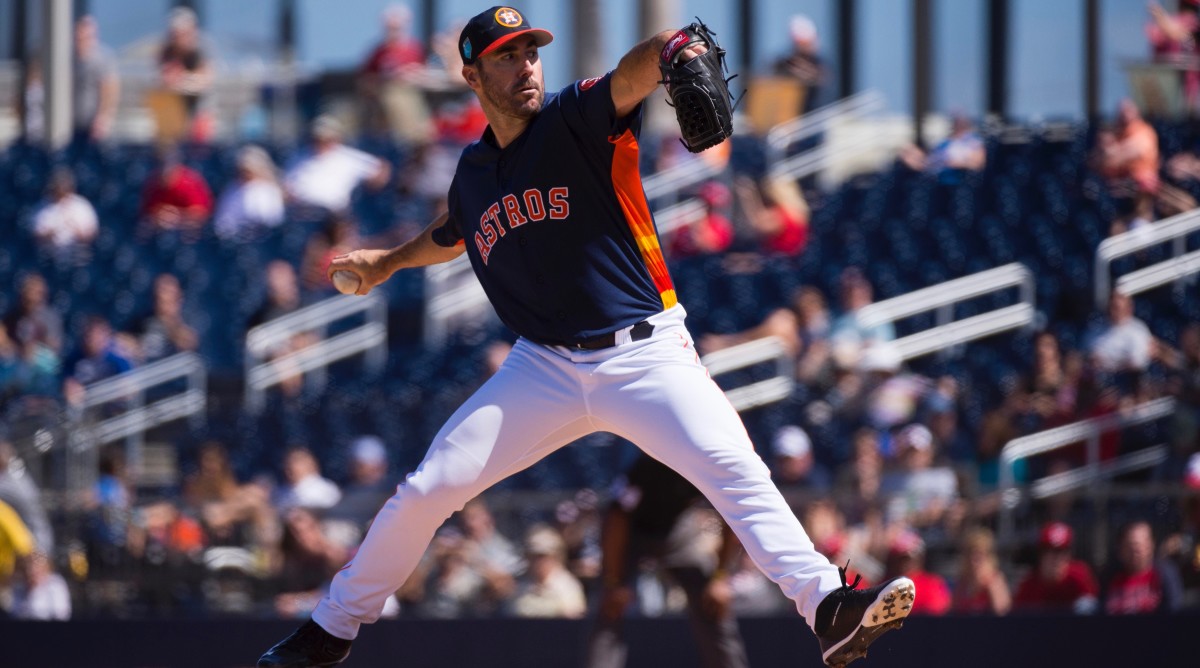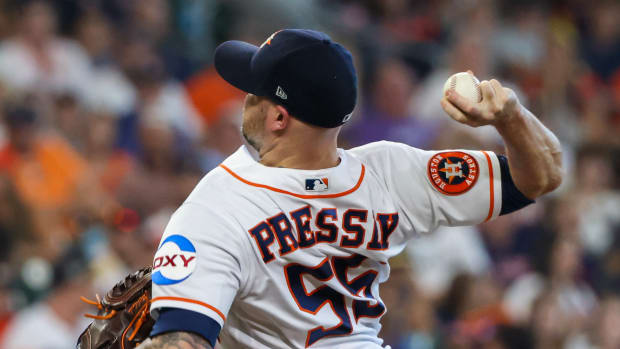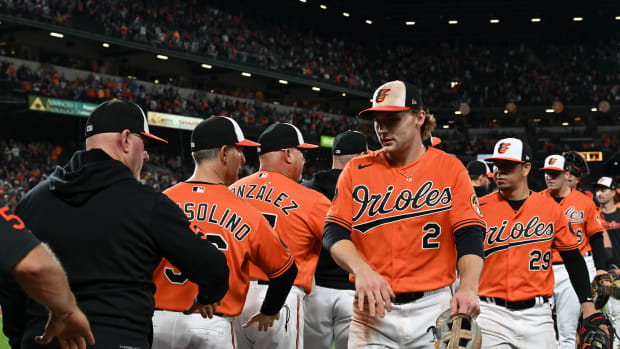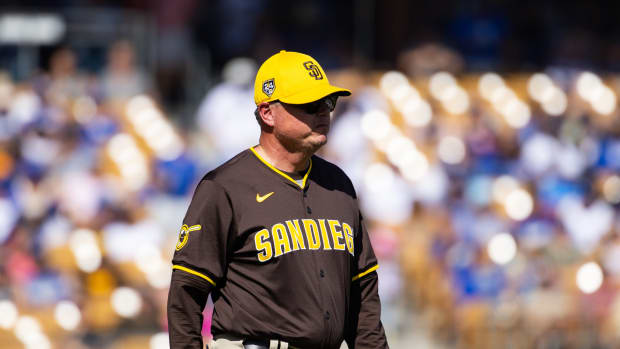Beware! Justin Verlander, Aroldis Chapman Among AL Fantasy Busts

The definition of sleeper may have changed over the years, but bust means today what it did 10 and 20 years ago, and what it will 10 and 20 years in the future. There are two types of busts. Those that completely flop, and those that play well enough, but don’t come close to justifying their draft-day price tag. We’ll feature both types in our look at AL busts for the 2018 season.
Two notes before we get going. A player needs to be a high- or middle-round pick to bust. No one cares if your 14th-rounder falls flat on his face. Given that, we set an average draft position cutoff of 100 to qualify as a bust. Pick No. 100 comes in the ninth round of a 12-team league, eighth round of a 14-teamer, and seventh round of a 15-teamer. Second, given that the potential bust pool is much shallower than that of sleepers or breakouts, there will be fewer players in these columns than those ones.
Dee Gordon, 2B/OF, Mariners (ADP: 33.2)
Stolen bases are at a premium across the league, with teams collectively running less often than ever before. Gordon has swiped 64, 58 and 60 bases in his last three healthy seasons, and is sure to push that mark again this year. He singlehandedly makes his fantasy teams a league-leader in steals.
And yet, his strength has made him significantly overvalued in fantasy leagues. Gordon will likely give you a plus-batting average as well, but he’s a drag on OBP and, as we’ve discussed before, everyone should be playing in OBP leagues. The run-scoring upside he had last year is gone. Seattle’s offense is nothing to sneeze at, but he won’t have a trio behind him that matches up to Christian Yelich, Giancarlo Stanton and Marcell Ozuna. In OBP leagues, he’s a one-category player, a slightly better version of Billy Hamilton. You’re really going to take someone like that over Noah Syndergaard or Alex Bregman or Brian Dozier?
It’s also worth noting that as stolen-base totals decline, so, too, does the threshold to compete in the category. Sure, you may not be among your league’s best if you don’t get Gordon, Hamilton or Jose Altuve. But consider the fact that what would have been a fantasy-league-average steals number five years ago is likely toward the top of most leagues today. Gordon swiped 60 bags last year. Hamilton stole 59. Whit Merrifield finished third with 34, and 30 players racked up between 15 and 30 steals. You can compete in the category without sinking a premium pick into Gordon, and, remember, that’s the only reason his ADP is so high.
Justin Verlander, SP, Astros (ADP: 39.85)
This really doesn’t have much to do with Verlander’s age. He has put together three great seasons in his 30s, including one of the best years of his career in 2016, when he was 33. We shouldn’t expect much, if any, dropoff now that he’s in his age-35 season. What this does reflect, however, is that Verlander has been among the most fortunate pitchers in baseball the previous few seasons, especially last year, and that regression could be coming for him in a big way.
Verlander had a 3.36 ERA and 1.17 WHIP in 206 innings last season. His xFIP, however, was 4.17, and his SIERA was 4.05. Among 58 pitchers who qualified for the ERA title, he ranked 31st in xFIP and 22nd in SIERA. He was one of 31 pitchers north of 4.00 in both metrics. Among those 31, he was one of 12 to post an ERA of less than 4.00, and that group doesn’t exactly include the best company. Jose Ureña. Andrew Cashner. Jhoulys Chacin. Those aren’t the names we expect to associate with Verlander.
What’s more, Verlander didn’t exactly limit hard contact. His hard-hit rate of 34.5% was the 13th-highest in the majors. Among the pitcher who allowed the 20 highest hard-hit rates, Verlander’s .271 BABIP was the third-lowest. Only Robbie Ray and John Lackey were luckier on balls in play. Add it all up, and there’s reason to believe that Verlander’s ERA pushes or surpasses 4.00 this season.
The strikeouts are going to be there for Verlander, and, with the defending World Series champions at his back, he’s going to win his fair share of games. Still, you don’t take a pitcher for the sake of two categories. Verlander is a rate risk, and his opportunity cost includes passing on the likes of Andrew Benintendi, Jose Abreu, Zack Greinke and Yu Darvish. Unless Verlander comes at a discount, I’m letting someone else take the risk.
Elvis Andrus, SS, Rangers (ADP: 63.04)
Andrus is a nice player. He has hit .302 and .297 the last two seasons. He has stolen at least 21 bases every year of his career, and has swiped 27, 25, 24 and 25 the last four years. He is a very safe floor player. Here’s the problem, though. This ADP requires you to buy into his ceiling, and his ceiling is driven entirely by the 20 homers he hit last year. We all know about the home run revolution that hit the majors last season, but do you really want to buy into a player who had 37 homers in more than 5,000 career plate appearances before last season repeating his 20-homer campaign? I sure don’t.
To be fair, Andrus took some of the steps you’d want to see if you’re buying into a power surge as legitimate. He increased his fly-ball rate by three percentage points from the previous season, his HR/FB ratio by five percentage points, and his average fly ball distance by 10 feet. Unsurprisingly, that came at the expense of his contact rate. Andrus set career-worst marks in strikeout rate (14.7%), whiff rate (8.5%), overall contact rate (81.9%), and contact rate in the strike zone (90.2%) and out of it (69.1%). He also swung at a higher share of pitches outside the zone (33.9%) than ever before. None of this is sustainable, and it seems impossible that he doesn’t give back some homers or average, if not both, this season.
Again, the price is the issue. If Andrus were coming off the board 20 picks later, there wouldn’t be a problem. Not only does his ADP leave little room for profit, it forces owners to pass on Aaron Nola, Khris Davis, Jonathan Schoop and Shohei Ohtani. Andrus simply isn’t worth that price tag.
Aroldis Chapman, RP, Yankees (ADP: 67.37)
I’ve made my stance on closers pretty clear. Even in this new era of bullpen management, I find it unconscionable to take one this early. There’s too much turnover at the position, and almost everyone comes out of the bullpen firing high-90s fastballs in the ninth inning. In other words, you can get the high strikeout totals and elite rates associated with the best closers much later than this in every draft.
If you’re going to take a closer this early, he has to be a sure thing. That’s why, even though I wouldn’t do it, I’m not going to argue too vehemently with the owners who make a run at Kenley Jansen or Craig Kimbrel. Chapman, though? He’s nowhere near a sure thing. He was legitimately bad for long stretches of the season last year, putting up a career-low 32.9% strikeout rate. He dealt with shoulder and hamstring injuries, with the former being particularly concerning for the future. Chapman was filthy over the final month of the season and during the Yankees run to the ALCS, but that can’t completely erase what he did the first four months of the year.
On top of all that, the Yankees bullpen runs as deep as any in the league. Should Chapman falter, or simply fatigue, Aaron Boone will be able to turn to any number of other relievers to take over the closer’s role, even if it’s only for a brief time. David Robertson, Dellin Betances and Tommy Kahnle are all capable closers, and the Yankees have eyes on a deep postseason run yet again. That means that Chapman could get more rest throughout the year than the typical high-level closer. There’s just too much risk here to pass on players like Jose Quintana, Daniel Murphy, Jean Segura and Justin Turner.
Whit Merrifield, 2B, Royals (ADP: 79.8)
Look, Merrifield is a fine player. I don’t think he can come close to repeating the 19-homer, 34-steal he had a season ago, but plenty of smart people who I respect do, and they could have a better read on the guy. I think he’s likely more a 12-to-15 homer and 20-to-25 steal player, which, again, makes for a fine player. But Merrifield is coming off the board in a typical draft right before Xander Bogaerts and Robinson Cano. Depending on your league, Daniel Murphy, Jean Segura and Justin Turner could all be available, as well. Come on, Merrifield backers. You’re being ridiculous.
I believe in Merrifield’s power more than his speed. His HR/FB ratio was a reasonable 9.4% last year. He also increased his fly-ball rate to 40.5%, which approximates what he did in 1,280 plate appearances at Triple-A across three seasons. It’s like he’s more that brand of player than the one that had a 29.8% fly-ball rate in 332 plate appearances with the Royals in 2016. Still, he had a total of 19 homers in those three years at Triple-A, where he spent most of his mid-20s. He’s likely a double-digit homer guy, but expecting him to push 20 again is a bit much.
Then there are the steals. Merrifield had a 4.6% walk rate last year and was never much for the free pass in the minors, so he’s going to have to hit his way on base. You can’t steal bag if you don’t first reach safely, and he had just a .324 OBP last season. That alone is enough reason to fade his 30-steal potential. If his average regresses, he could give back 10 or more points of OBP this year.
Finally, Merrifield won’t have the same run-scoring upside as most leadoff men. Lorenzo Cain, Eric Hosmer and Mike Moustakas have all left Kansas City. The Royals have real potential to be the league’s worst offense, and will almost certainly be among the trailers in runs. I’m not using one of my first eight or nine picks on a player with so much identifiable downside, especially when I have every reason to believe I can get Bogaerts or Cano at the same price.




































